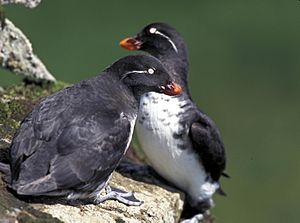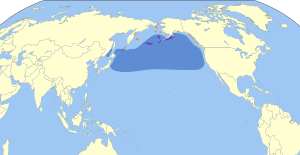Parakeet auklet facts for kids
Quick facts for kids Parakeet auklet |
|
|---|---|
 |
|
| Conservation status | |
| Scientific classification | |
| Genus: |
Aethia
|
| Species: |
psittacula
|
 |
|
| Synonyms | |
|
Cyclorrhynchus psittacula |
|
The parakeet auklet (Aethia psittacula) is a small seabird that lives in the North Pacific. These birds are found in the cool waters near Alaska, Kamchatka, and Siberia. They build their nests on cliffs, slopes, and rocky areas of islands. In winter, they usually fly south to warmer places.
Scientists used to think the parakeet auklet was in its own group. But new studies show it is closely related to crested auklets and least auklets.
Description
The parakeet auklet is a small bird, about 23 centimeters (9 inches) long. It has a short, orange beak that points upwards. This gives the bird a very unique look. The upward bend of its beak helps it pick up tiny food pieces from the ocean floor. It also helps break apart bigger food items.
The bird's feathers are dark on top and white underneath. It has a single white feather that sticks out from behind its eye. Its feathers look slightly different between the breeding season and winter.
Parakeet auklets are very noisy when they are at their nests. They call out when they arrive. When their mate joins them, they often sing together. They make rhythmic, rough calls and a shaky squeal. These calls might help them protect their nests from other birds. They may also help them stay close to their mate.
Behaviour and Life Cycle
The parakeet auklet's diet changes with the seasons. During the breeding season, they mostly eat small ocean creatures. These include tiny crustaceans like euphausiids, copepods, and amphipods. Some recent studies show they also eat jellyfish in certain areas.
They often fly far from their nesting colonies to find food. They can dive up to 30 meters (100 feet) deep to catch their prey.
Breeding starts in April and May. Parakeet auklets often nest in large groups with other auk species. The pair lays one egg. The egg is kept warm for a little over a month. After hatching, the chick is fed about four times a day for around 35 days. The young bird leaves the nest at night. It flies out to sea all by itself.
Status and Conservation
The parakeet auklet is not considered to be in danger. There are more than a million of these birds in the North Pacific. Their numbers do not seem to have gone down recently. However, they could face threats in the future. These threats include animals brought to their islands that might eat them. Oil spills could also harm them.
Images for kids
-
A close-up of a parakeet auklet's head in the Pribilof Islands, Alaska.
See also
 In Spanish: Mérgulo lorito para niños
In Spanish: Mérgulo lorito para niños




